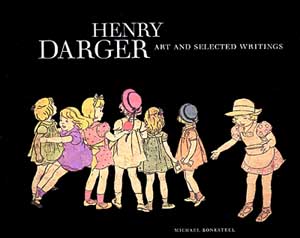|
Rescuing Henry Darger
It's clear that Michael Bonesteel's mission in "Henry Darger: Art and Selected Writings" is to rescue the loner artist of Webster Avenue from his most obvious appeal -- weirdness. Darger is a major figure in 20th Century American art, and Bonesteel's disciplined introductory essay adds significantly to the well-known scraps of his story while avoiding the overreaching analysis so common to writing on outsiders. His description of Darger's creative methods serves to give him more coherence as an artist, while the account of Darger's one known adult friendship, references to the real life people whose names Darger used in his fiction and similar biographic items add social texture to a life that has seemed obscured in surreal isolation. This approach is opposite that of the typical outsider life story. Rather than sensationalizing the strangeness of Darger's life, Bonesteel, a Chicago-based art critic and member of the Intuit board, manages to make him seem less the isolated other. The biography illuminates the work rather than wrapping it in a romantic eccentricity. Oddity still finds easy resonance with the violence of Darger's most extreme paintings, however, with the misapplied penises on little girls and with the whole vast loneliness of his obsessive artistic enterprise. And the rich illustrations in this volume include a couple of the most bizarre of Darger's set pieces, showing children crucified and, in distressing anatomical detail, gutted.
The literal narrative -- the writing that is the largest part of Darger's life work -- constitutes the bulk of this book. Anyone passingly familiar with the artist knows about the thousands of pages of the Realms of the Unreal, and here's finally a chance to read a substantial selection. To a sympathetic reader, even in this much-abridged form there is some rough going. Depending on your sympathies, for example, you may find the exaggerations ("hundreds of thrillions of men") and the place names (Vivian Wickey, Abyssinkile) childlike or childish, the lengthy descriptions fascinatingly obsessive or tediously detailed, and the elisions ("a fury that no one could describe correctly") evasive or suggestive. But the written work nonetheless turns out to be far more interesting and entertaining than you might expect. Together with a too brief-selection from Darger's diary, it also demonstrates a surprisingly high degree of personal and artistic self-consciousness. Darger may have been queer, he may have been compulsive, but it seems clear that to a great extent he knew what he was about. As Bonesteel contends, the outsider stereotype usually applied to Darger is way wide of the mark. If Darger was truly unusual, it was in the same sense that anyone approaching genius is bound to be. And indeed, Bonesteel is not out to make Darger seem ordinary. "Reading Darger's Realms and viewing his art can be like entering a trance," he writes., having declared, "He did not do this to make 'art' or 'literature.' He did not do this to gain fame or make money. He did it to save his life." Even if you don't have the patience to wade through the written fragments of the "luminous and bewildering hybrid ... of unfettered childhood bliss and remitting psychological torment," dozens of pictures still reward with fresh insights. The size and color reproduction cannot do justice to work on Darger's scale, but this is an inevitable limitation of any book. These images afford a deeper appreciation of Darger's achievement while making you also look forward to the day when his greatest work is on permanent and wide public display. We should also be looking forward to additional publications. This books presents one clear opportunity in how it treats Darger's writing. Although there is a note stating that the text has been massaged for publication, it is impossible to tell how much and where. In Darger's case, where rawness is fundamental to what is being appreciated, the reader should at least be given specifics on exactly where an editorial process has been applied, and how rigorously. Thorough notes, or clear examples, would have given the reader more confidence in the integrity of the excerpted text. The most urgently required addition to the Darger literature, however, is the book-length study by John MacGregor, which is the fruit of years of research and remains unpublished in English. Darger completists can acquire versions in French and Japanese, and despite the obvious limitations to English speakers, they have their own virtues. The French-language volume includes significant untranslated extracts from Darger's writing as well as a number of pictures not included in the American book. The pictures in the Japanese edition mirror the American more closely, but the selections still vary and include details from some of Darger's grisliest works. In any case, the fact that MacGregor's work has not yet been published in English is reason to hope that the Bonesteel book, while the first in English, is not the last to be published. The research to date has not come close to dissipating the mystery of Darger's work and its meanings -- as Bonesteel himself agrees. You'd never want the mystery to be completely dissolved, of course, and it probably can't be. But as this book demonstrates, the facts of Darger's life add to the power of the work without trivializing it. This review originally appeared in Intuit's Outsider magazine.

|
The Latest Stuff | Roadside art | Outsider pages | The idea barn | About | Home
Copyright Interesting Ideas 2001
 Henry Darger: Art and Selected Writings
Henry Darger: Art and Selected Writings
